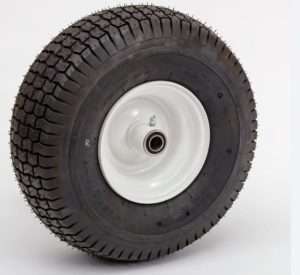Upgrade Your Lawn Mower Tires with Valve Stems
Looking for ways to maintain your lawn mower’s tires? Check out this comprehensive guide on valve stems for lawn mower tires and learn how to keep your machine rolling smoothly!
One essential component of your lawn mower that is often overlooked is the valve stems for the tires. These small but mighty pieces play a critical role in maintaining proper tire pressure and ensuring your lawn mower runs smoothly.
In this guide, we will explore everything you need to know about valve stems for lawn mower tires, including types, installation, and maintenance.
Types of Valve Stems for Lawn Mower Tires
There are several different types of valve stems for lawn mower tires, each with its own unique features and benefits. Here are a few of the most common types:
- Snap-In Valve Stems: These are the most common type of valve stem for lawn mower tires. They are easy to install and remove, making them a popular choice for homeowners.
- Bolt-In Valve Stems: Bolt-in valve stems are more secure than snap-in stems and are often used for higher-speed applications. However, they are also more difficult to install and require special equipment.
- Clamp-In Valve Stems: Clamp-in valve stems are similar to bolt-in stems but are easier to install and remove. They provide a secure seal and are often used in off-road applications.
- Tubeless Valve Stems: Tubeless valve stems are designed for use with tubeless tires and are typically made of high-quality materials that can withstand extreme temperatures and pressure.
Why Are Valve Stems for Lawn Mower Tires Important?
Before we dive into the details of valve stems for lawn mower tires, let’s discuss why they are so important. Here are a few key reasons:
- Proper tire pressure: Valve stems play a critical role in maintaining proper tire pressure, which is essential for achieving optimal performance and longevity from your lawn mower.
- Prevent tire damage: Without proper valve stems, tires can become damaged due to underinflation or overinflation, which can lead to costly repairs or even the need for replacement.
- Safer operation: Lawnmowers with properly inflated tires are easier to maneuver, making them safer to operate and reducing the risk of accidents.
Here you can also check the Valve Stems Size Chart
How to Install Valve Stems for Lawn Mower Tires
Installing valve stems for lawn mower tires is a relatively simple process that can be done in just a few steps. Here’s what you need to do:
- Remove the old valve stem: Use a valve stem removal tool to remove the old valve stem from your lawn mower tire. Be sure to wear protective gloves and eyewear to avoid injury.
- Clean the rim: Use a wire brush to clean the rim where the valve stem will be installed. This will help ensure a tight seal and prevent air leaks.
- Insert the new valve stem: Insert the new valve stem into the rim, making sure it is properly aligned and seated. Use a valve stem installation tool to tighten the stem in place.
- Inflate the tire: Use a tire gauge to check the tire pressure and inflate the tire to the recommended PSI.
- Check for leaks: Apply a soapy water solution to the valve stem to check for leaks. If you see bubbles forming, tighten the valve stem further or replace it if necessary.
Maintaining Valve Stems for Lawn Mower Tires
Proper maintenance of valve stems for lawn mower tires is essential for ensuring they function optimally and last longer. Here are a few tips to keep in mind:
- Check tire pressure regularly: Tire pressure can fluctuate over time, so it’s important to check it regularly and adjust as needed. Be sure to follow the manufacturer’s recommended tire pressure for your specific lawn mower.
- Inspect valve stems for damage: Regularly inspect valve stems for any signs of damage, such as cracks or corrosion. If you notice any issues, replace the valve stem immediately to prevent further damage to the tire.
- Lubricate valve stems: Applying a small amount of lubricant to the valve stem can help prevent corrosion and make it easier to remove and install the stem.
- Replace valve stems when replacing tires: If you’re replacing your lawn mower tires, it’s a good idea to replace the valve stems at the same time. This will help ensure the proper function and longevity of your new tires.
Conclusion
Valve stems for lawn mower tires may be small, but they play a critical role in maintaining proper tire pressure and ensuring your lawn mower runs smoothly.
By understanding the different types of valve stems, how to install them, and how to maintain them, you can help ensure optimal performance from your lawn mower for years to come.
Remember to check your tire pressure regularly, inspect valve stems for damage, and replace them when necessary. With the right care and attention, your lawn mower will keep your lawn looking great for years to come.
Frequently Asked Questions
Q: Can I replace a valve stem myself?
A: Yes, replacing a valve stem for lawn mower tires is a relatively simple process that can be done with basic tools. However, if you’re not comfortable doing it yourself, it’s always a good idea to take your lawn mower to a professional.
Q: How often should I check my tire pressure?
A: It’s recommended to check tire pressure at least once a month or before each use of your lawn mower. Changes in temperature or prolonged periods of inactivity can cause tire pressure to fluctuate.
Q: What happens if I over-inflate my lawn mower tires?
A: Over-inflating lawn mower tires can cause them to wear out faster and can make your lawn mower difficult to maneuver. It can also lead to blowouts or other tire damage.
Q: What type of valve stem is best for my lawn mower tires?
A: The type of valve stem you need depends on your specific lawn mower and application. For most homeowners, snap-in valve stems are the best choice due to their ease of installation and affordability.



